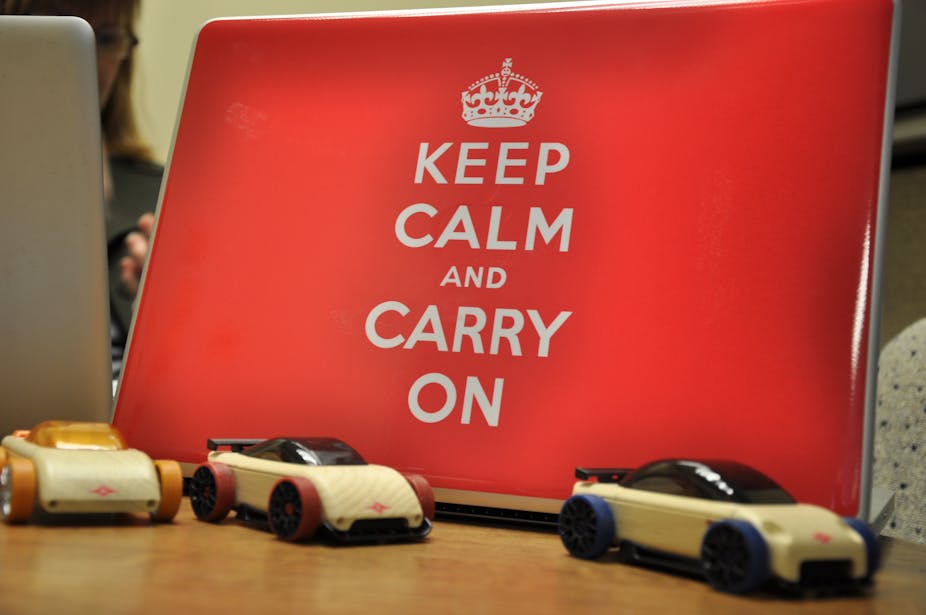In the heart of Northumberland, England, is the pretty town of Alnwick. For bibliophiles, a stop at its second-hand bookshop is a must. Barter Books is housed in the town’s old railway station and, on its outside wall, the shop’s owner Stuart Manley has hung a piece of ephemera, a World War Two poster that reads “Keep Calm and Carry On”.
The problem is that Mark Coop, a businessman, trademarked the phrase in 2011. Coop saw an opportunity to create a monopoly of souvenir mugs, aprons and the like bearing this slogan. He even copied the poster design, and ever since this unremarkable English phrase has been taken out of the public realm and is now privately owned.
If an article is written about banking, and suggests that a particular institution which has branches in every time zone is a “bank that never sleeps”, it can only use that common phrase to refer to Citibank, because that phrase has been trademarked by Citibank and is now its private property.
At a school sports event, you should forget putting up a sign that says “Just Do It” unless Nike is the sponsor.
A poet wishing to use the phrase “between love and madness lies obsession” may find themselves in trouble because Calvin Klein has trademarked the expression for its line of Eau de Parfum products.
And anyone thinking of writing a memoir and wishes to recall happy times reading Winnie the Pooh books may be forced to pay a license fee to Disney, which has trademarked the book’s characters.
Disney has current form in this area. The company has recently dropped a bid to trademark “Dia de los Muertos”, the name of the traditional “Day of the Dead” holiday celebrated by millions in Mexico.
If successful, it would have given Disney exclusive rights to use the name on merchandise - and presumably prevented Mexicans from doing the same without paying a license fee to Disney.

Perhaps the most egregious example of the takeover of the language is the aggressive approach taken by McDonalds to stop any retailer using “Mc” in its trading name. In 1996, McDonald’s threatened to take Mary Blair of Buckinghamshire, England, to court because she had called her sandwich shop McMunchies. Blair told the London Times:
This is a small corner shop. We sell cold sandwiches, cold meats.
It is hard to believe that anyone could confuse McMunchies, which sells neither burgers nor chips, with a McDonald’s franchise. That is, anyone but McDonald’s, which issued a statement explaining that the prefix “Mc” was the firm’s property:
If someone, either deliberately, or unintentionally, uses our trademarks in their own food or restaurant-related business they are effectively using something that does not belong to them.
In France, the modern concept of trademarks appeared in 1857. The Manufacture and Goods Mark Act allowed owners to register and protect their trademarks. This law marked the first time a trademark as was recognised as property with its own intrinsic value and legal rights.
Few would disagree that brands have a right to protect themselves from counterfeiters. For instance, Coca-Cola should be able to stop another company trying to pass off its soft drink for the real thing. But should Coca-Cola be able to trademark the “the real thing”, taking ownership of the phrase in perpetuity?
Once, trademarks were only used to protect logos and brand names. This changed in 1923, when Edgar Rice Burroughs registered “Tarzan” as a trademark. This allowed his estate to circumvent the limited time it could legally enjoy profits from its copyright.

There are other examples of how trademarks have extended well beyond their original purpose. In 1995, photographer Charles M. Gentile made a poster of the I. M. Pei building, which houses the Rock and Roll Hall of Fame and Museum in Cleveland, Ohio. Gentile was surprised when he discovered that the museum intended to sue him for infringing its trademark over its own image.
The implications of this extension of trademarks are mindboggling. If artists and photographers need to pay license fees to use trademarked images of public buildings, it would represent a private tax on artistic expression.

The next target for trademark lawyers has been the colour spectrum. In November 2002, Mars applied to trademark “Whiskas purple” for its cat food packaging, and it was successful in doing so in 2010.
Justice Bennett of the Australian Federal Court accepted the argument that Mars invented the colour specifically for its cat food range. Considering the infinite palate employed by Mother Nature, might not the good lady find that she has inadvertently used “Whiskas purple” on some animal or plant, and find herself paying Mars a licence fee?
Companies may well spend millions of dollars coming up with catchy slogans, and a small fortune promoting those slogans to consumers. That, however, does not mean that they should be allowed to take exclusive ownership over parts of the language, or for that matter public images and now colours. A company can adequately protect its brand from imitators using a distinctive name and logo. The two work together to provide a unique identifier.
Trademarking advertising slogans, however, is unnecessary. Companies should not be able to legalise “squatters’ rights” to what is, after all, public property.

